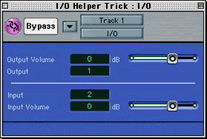Support Report: The I/O Helper Trick for Logic Audio
 Most of the Logic users I’ve had the pleasure to talk to are nuts. Borderline fanatics. I mean they really love Logic. And for good reason too. It’s an extremely flexible application that can do things no other app on the market can. But if you are Logic user who has the pleasure of owning the UAD-1, then it’s quite possible you could have experienced some ill side-affects (clicking, popping, stuttering or crashing) in your system when you use the UAD-1.
Most of the Logic users I’ve had the pleasure to talk to are nuts. Borderline fanatics. I mean they really love Logic. And for good reason too. It’s an extremely flexible application that can do things no other app on the market can. But if you are Logic user who has the pleasure of owning the UAD-1, then it’s quite possible you could have experienced some ill side-affects (clicking, popping, stuttering or crashing) in your system when you use the UAD-1.
Here’s the problem:
The problem is the clicking, popping, stuttering or crashing problems that may occur when UAD-1 plug-ins are used where their input is derived from any source in a "live mode". These sources include: record-enabled audio tracks, selected audio instruments tracks, auxes or any busses or outputs that receive input from such sources. There are three possible "execution contexts" i.e. "modes", in which PPI’s(Powered Plug-Ins) can be called within Logic. This I/O helper workaround forces the UAD-1 plugs to run as they need to, which is all under one "execution context" namely, the aforementioned "live mode", thus eliminating the problems. We are working with Emagic to address the cause of this issue, but in the meantime the I/O helper workaround does the “trick”!
Here’s the solution:
- On every track that you plan on using PPIs, first add an I/O helper plug-in:
(Track Insert> plugin menu>Logic->Helper->I/O).
- On the I/O plugin editor, select a valid input and output channel
(not "---", which is the default), then disable (bypass) the I/O plugin.
- Now add your PPI.
Note: It is important that the I/O helper plug be instantiated (called up) before the PPI. This is to ensure that the PPI is never called in an "improper execution context", even temporarily. If you are adding the I/O helper to a project that already has PPIs running, be sure to stop playback first, then add your I/O before resuming audio. This will assure that you PPIs will never be called in an “improper execution context”. If you want to add a PPI while the transport is playing, just make sure you add the I/O helper first to once again avoid the dreaded “improper execution context”.
Another Note: The I/O Helper plug-in became a feature with Logic Audio version 5.2.0. So, this workaround will only help those running Logic 5.2 or later.
Yet Another Note: The I/O helper trick has a side benefit for dual processor users in that it forces any plug-ins on a track using the I/O helper to run on the main processor. This can be handy in squeezing a little more plug-in power out of your system when using the PPI’s along with host-based plug-ins.
Still Yet Another Note: An end-user recently discovered, and Emagic confirmed, that there is a small bug with the I/O helper itself, so I thought I should mention it briefly. It involves using the I/O helper on audio instruments that are sending to multiple AUX tracks (for example a virtual drum machine sending out discrete drum sounds on a per track basis, rather than just to a stereo bus). The result is distorted audio.
Just make sure you have the I/O helper on the audio instrument AND the auxes the audio instrument is sending to.
So the bottom line "I/O Helper for Dummies" solution is:
Whenever a UAD-1 plug is used, a disabled I/O helper should also be used. EVERY track, EVERY group, AND your master fader needs the I/O helper too, if it's using a UAD-1 plug-in. And don't forget to insert the I/O helper BEFORE you call up the UAD-1.
Now--get back to making some music!
--Will Shanks
Questions or comments on this article?